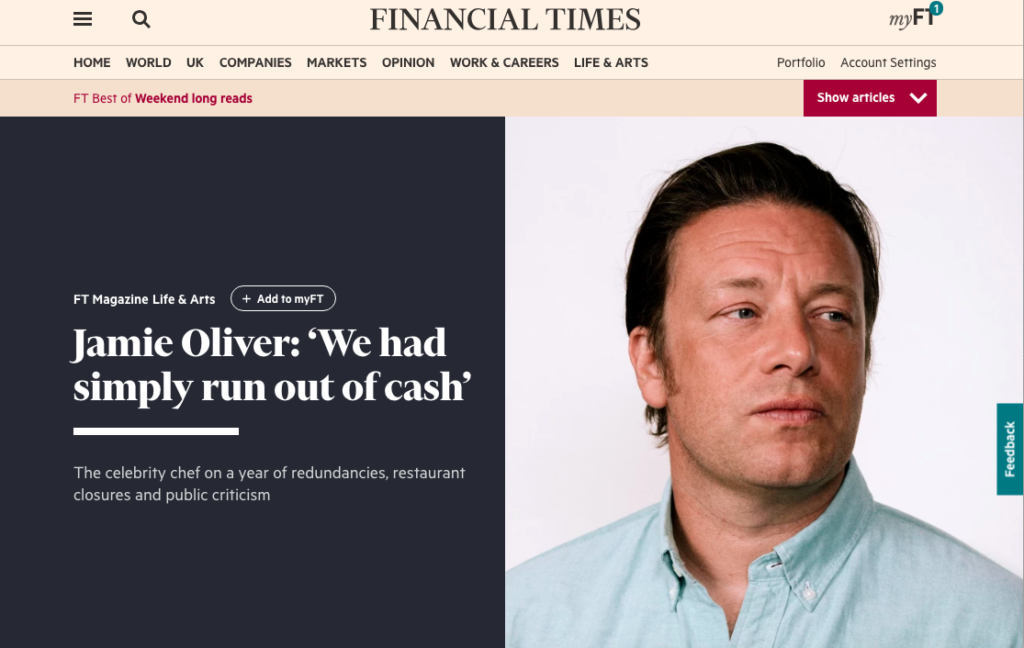
In his first interview after his well-publicised difficulties with Jamie’s Italian, Jamie Oliver gave access to the FT this week to present his case about what went wrong at the troubled group.
His most gripping revelations surround the day he suddenly learnt that he was going to have to write a personal cheque for £7.5m to keep his restaurant business from tanking completely:
“I had two hours to put money in and save it or the whole thing would go to shit that day or the next day. It was as bad as that and as dramatic as that”.
Dramatic indeed. But while the FT’s Mark Edmonds doesn’t shy away from including some difficult questions, his probing of the famous TV chef on this point seems rather light touch.
“We had simply run out of cash. And we hadn’t expected it. This is just not normal, in any business.”
No kidding.
“You have quarterly meetings. You do board meetings. People supposed to manage that stuff should manage that stuff.” A surprisingly sharp tone in his voice suggests that someone let him down and he was none too pleased.’
Perhaps Mark Edmonds could have suggested that the person supposed to manage that stuff was the person he was interviewing, the person with his name over the door, the person whose persona is the main reason folks visit the place. But it slips by. (Did Jamie’s PR people have approval over the final copy at all?)
Oliver we learn:
was left with no choice but to instruct his bankers to inject £7.5m from his own savings into the restaurants. A further £5.2m of his own money would follow over the next few months. Last year, Oliver was said to be worth £150m. Even so, £12.7m is not the kind of money that slips back down the back of a sofa, vintage or otherwise.
It is not explored in the article what “no choice” actually meant. The cross- or personal-guaranties that might have existed respecting the business are not enquired after. Did Jamie put in the money because he had to protect his name, or because he was legally obliged to do so?
We do learn however that the amount put in was topped up by £37m of loans from HSBC and subsidies from other companies from within the Jamie Oliver Group.
We also learn later from Jon Knight, the new CEO of the restaurant group, that
Knight has promised Oliver that within four years he will bring the chain “back to value” – that is, in profit and clear of debt. Oliver, he says, will get his money back, “or at least most of it”.
And yet later we learn that the profits from the media side of Jamie’s business combined with its licensing profits are £13.1m in 2017, so the amount of money concerned supporting the restaurant business – while certainly non-trivial – is less than the annual profits from the media side.
Although the controversy that has attached to job losses and not paying suppliers in the restaurant group is alluded to, another point that slips by unquestioned is that:
In February, he [Jamie] was also forced to take out a controversial “pre-pack” arrangement that enabled him to cling onto one of his two Barbecoa steak restaurants.
Who forced him? Was it at gun-point? Or did “forced” mean with a view to salvage as much money as possible. Again, one has the feeling the FT could have pushed harder on this potentially unfavourable point.
We learn that:
Oliver’s is not the only mid-market restaurant group in trouble.
with the article also mentioning the travails of Gaucho, Byron, Strada, La Tasca. Café Rouge and Carluccio’s. We learn
“The market is simply too crowded. There is too much competition and business rates, rents and other costs… Expansion has happened too quickly and, in the haste to expand, a lot of the sites that have been chosen are, shall we say, sub-optimal”… the company had been investing in newer locations which are simply unsuitable”… “we were opening too many restaurants too quickly, in the wrong places. We were opening in places that weren’t tourist towns and didn’t have enough of a tourism element.”
Er, or could it have been that the branches of Jamies Italian that they were opening were merely bad restaurants?
Knight [the new restaurant group CEO] also points to a disconnect between the restaurants and the rest of Oliver’s business. “The customer would go and buy Jamie’s latest book, would sit at home and watch Jamie on Channel 4, but then he or she would go to eat at Prezzo. That was our problem. We couldn’t see why – they loved the books, the TV programmes, [so] why aren’t they coming into the restaurants. His restaurants… “We had become complacent,” says Loftus [Oliver’s food and beverage chief]. “Our entry-level steak is now £15.50 when it was £17”.
There you go then. Knock £1.50 off the steak and job done! Bish Bosh! Jamie’s natural TV market will then re-connect with the business and ditch Prezzo!
Are Jamie’s Italian’s problems really so superficial and easily fixed? If they are not, this article is certainly not going to dig into finding out what they might be.
Was Jamie’s Italian performing better or worse than similar groups. Not the article to find out.
In Harden’s London Restaurants 2011, the Jamie’s Italian review said that some reporters “expected more of a Jamie Oliver restaurant”. By the 2015 guide it read as follows:
“How does he get away with it?”; although these cult-of-Jamie diners do have have their fans (especially ‘en famille’), few chains incite as much harsh criticism as this one, with many reporters finding them “completely overrated”, “lamentable”, “the most disappointing ever”…
Who would have seen trouble coming eh?
